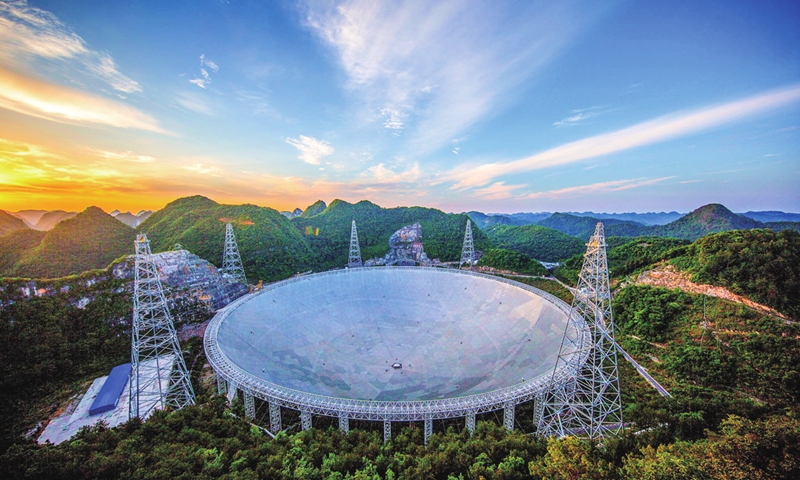
An aerial view of the 500-meter Aperture Spherical Radio Telescope (FAST) in Pingtang county, Southwest China's Guizhou Province Photo: courtesy of FAST
China launched the construction of the testing prototype for the Five-hundred-meter Aperture Spherical Radio Telescope (FAST) Core Array on Wednesday, aiming to greatly enhance the astronomical observation capability of the FAST telescope.
At 10:30 am, a 40-meter aperture antenna started to be installed on a hilltop less than three kilometers away from the current FAST site, also known as the China Sky Eye, located in a naturally deep and round karst depression in Southwest China's Guizhou Province.
In order to further raise FAST's scientific observation capability, the team behind the project proposed a low-cost, quickly implementable plan of a radio telescope array. According to this plan, the well suited electromagnetic environment within 5 kilometers surrounding FAST will be fully utilized to construct 24 fully rotatable 40-meter-diameter antennas, which will function as a synthesis aperture array when combined with FAST, known as the FAST Core Array, according to CCTV.
Adding auxiliary telescopes around FAST is equivalent to turning FAST into a telescope with a much larger aperture, which will raise the observation capability of FAST, Zhu Weiwei, researcher from the National Astronomical Observatories of the Chinese Academy of Sciences (CAS), explained, CCTV reported.
When the FAST Core Array is completed, it will significantly improve the "eyesight" of the China Sky Eye by allowing it not only to see far but also with a higher degree of clarity, said Jiang Peng, deputy director of the National Astronomical Observatories of the CAS, noting that the FAST Core Array functions are similar to a high-resolution "digital camera" that captures the distant starry sky, according to Xinhua.
The FAST Core Array will significantly expand the existing scientific research fields. In particular, it will play a major role in areas such as gravitational wave events, fast radio bursts, gamma-ray bursts, supernovae, and black hole tidal disruption events. In addition to astrophysics research, the FAST Core Array can also play a role in deep space exploration field such as near-Earth object early warning and deep space satellite communications, providing important strategic support for the development of China's aerospace sector.
FAST is the world's largest single-dish and the most sensitive radio telescope. Since it started operation, FAST has achieved numerous significant original breakthroughs in multiple areas in the discovery of pulsars, fast radio bursts and nanohertz gravitational waves.
Global Times

